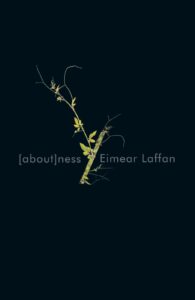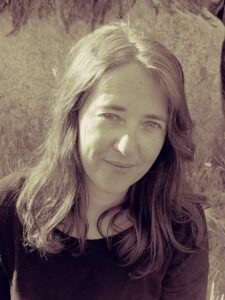‘Violet notions’
[about]ness
by Eimear Laffan
Montreal: McGill-Queens University Press, 2023
$19.95 / 9780228019022
Reviewed by Steven Ross Smith
*

What is Eimear Laffan’s “ness” really “about”? This reader ponders the matter continually through the marvellous poetic constructions that stretch the bounds of current normative poetry.
My first glance quivers at the prose-poemish paragraphs broken by slashes (“/”, “//”) and blank interjections (like “ “ and “[ ]”); and then by big white-space gaps, redactions, a cross-out, and the odd underlining. Later come pieces that look like verse, but retain eccentricities. In short, Laffan presents many forms. But this is just seen on a flip-through.
Now the words gesture, demand attention, such as: “certain nights I write snow / to situate myself inside its ‘o’.” Or: “you can be born again / if not from the womb / from the wound / if not from the wound / from its echo.” Then whole poems assemble. It’s an ensemble presentation.
Exterior reference combines with the intimate personal, with nature, myth, and divinity, in a disjunctive non-pattern that disorients understanding and engages contemplation at the same time. Along the way Laffan cites or references, from her apparent wide reading, Zbigniew Herbert, Derek Walcott, Nietzsche, Barthes, Agnes Martin, and Luce Irigaray, among others.
Laffan is Irish-born, and now writing in Nelson, B.C. These multi-faceted spaces call and reverberate too in the embrace of her imaginative scope.
In her first poem Laffan sets the stage with references that recur in moments elsewhere: “I exiled myself to the ministry of mountains and monotony / a ghost to all my unlived lives”; and then a few phrases later, “how the chess move that follows you to the land of Douglas firs / the body host to a wound that keeps returning.” The poet searches for a self and writes to re-vision being and circumstance: “for gods to live certain images need to disappear.” Perhaps writing to erase, Laffan however evokes ‘appearances.’
In her recurrent self-referentiality, Laffan features the pronoun ‘I,’ yet it seems to transcend–engaging self or disguise or lens to a broader scope. The work is not confessional or memoir-in-verse, not narcissistic. She’s cautious of the self-bind:
this is a performance, as much rope
as you concede, I will take
too much traction in one direction
causes slack, turns Narcissus up–
And while the poet writes of her process in thought and awareness, she also dwells in the work of the poetry itself: “if a matrix of this work exists / it alights in the furrows / an accident of production.” With this cognizance, Laffan turns probing and experiential, but more often existential and expansive.

Superscript numbers ride phrases in the prose poems as linking devices, leading (as often in academic texts and such) to a “Notes” section near the book’s end, containing elaborations that are actually discrete poems, versed or prosy, and intriguing reads unto themselves. This is a ‘chaining’ concept I’ve seen in other works, such as those of bpNichol and Phil Hall, creating layered, puzzle-like intersections.
Laffan makes the poem perform, within the confines of the page. This brings me back to her forms, the shapes and layouts. Mentioned earlier is the slash–technically called virgule, solidus, or even whack–and I’ve referred to her use of white space. Along with these Laffan sometimes skinnies the poem, bifurcates (or perhaps ‘binaries’) it into columns, justifies it with centring and/or ‘lefting,’ tosses it down by word scattering, rolls it out in verse, paragraph, couplets, a list, and what might be seen as a formula.
These diverse forms disrupt the notion of a smooth read, the ‘page-turner’ offering poetic insights, perfect metaphors, and epiphanies (though epiphanies may occur). Rather, her renderings unsettle poetry’s sometimes role as medicine, commodity, or aperitif.
The work vibrates in the poet’s restlessness, its searching, unpredictable reach. The content of this book cannot be reduced to a succinct synopsis. Its multiplicity must be dwelt in.
Amongst serious contemplations of being, religion, love, and more, there is humour and critique, as in “should I die no one will scour my drive / to salvage the rune […] my personal madeleine a cheap cherry Chilean […] Karl Marx has become a project manager according to LinkedIn.“
I opened this review with a question. Reading through, I come perhaps upon the answer and a key to Laffan’s method, where she writes: “((The question, what is it about, obliges circumlocution.))” Then: “I keep trying to make / the bricolage connect / for accretion to amount to coherence.” Indeed, she writes around, and through, and into. Her “ness” is poetry–probing, inventive, clever, fun, provocative, and challenging.
She claims: “I have violet notions. To rend the monochrome. To aberrate.” Dwelling in her notions, with attention, splice by splice, leap by leap, reaps vibrant rewards.
*

Steven Ross Smith, Banff Poet Laureate 2018-21, loves live music and walking on beaches and in forests. He is less enthralled, though consistent, with his physiotherapy-induced workouts. His poetic work often juxtaposes disparate threads, as in his seven book series fluttertongue.His fourteenth book is Glimmer: Short Fictions. Three collaborative chapbooks have appeared with Jackpine Press; The Green Rose, a collaboration with Phil Hall, has appeared from above/ground press. Over many years Smith has migrated westward from Toronto to Saskatoon to Banff, and he now lives and writes in the region of the W̱SÁNEĆ peoples, Victoria, BC. [Editor’s note: Smith recently reviewed Tim Lilburn for BCR.]
*
The British Columbia Review
Interim Editors, 2023-25: Trevor Marc Hughes (non-fiction), Brett Josef Grubisic (fiction)
Publisher: Richard Mackie
Formerly The Ormsby Review, The British Columbia Review is an online book review and journal service for BC writers and readers. The Advisory Board now consists of Jean Barman, Wade Davis, Robin Fisher, Barry Gough, Hugh Johnston, Kathy Mezei, Patricia Roy, Maria Tippett, and Graeme Wynn. Provincial Government Patron (since September 2018): Creative BC. Honorary Patron: Yosef Wosk. Scholarly Patron: SFU Graduate Liberal Studies. The British Columbia Review was founded in 2016 by Richard Mackie and Alan Twigg.
“Only connect.” – E.M. Forster
2 comments on “‘Violet notions’”